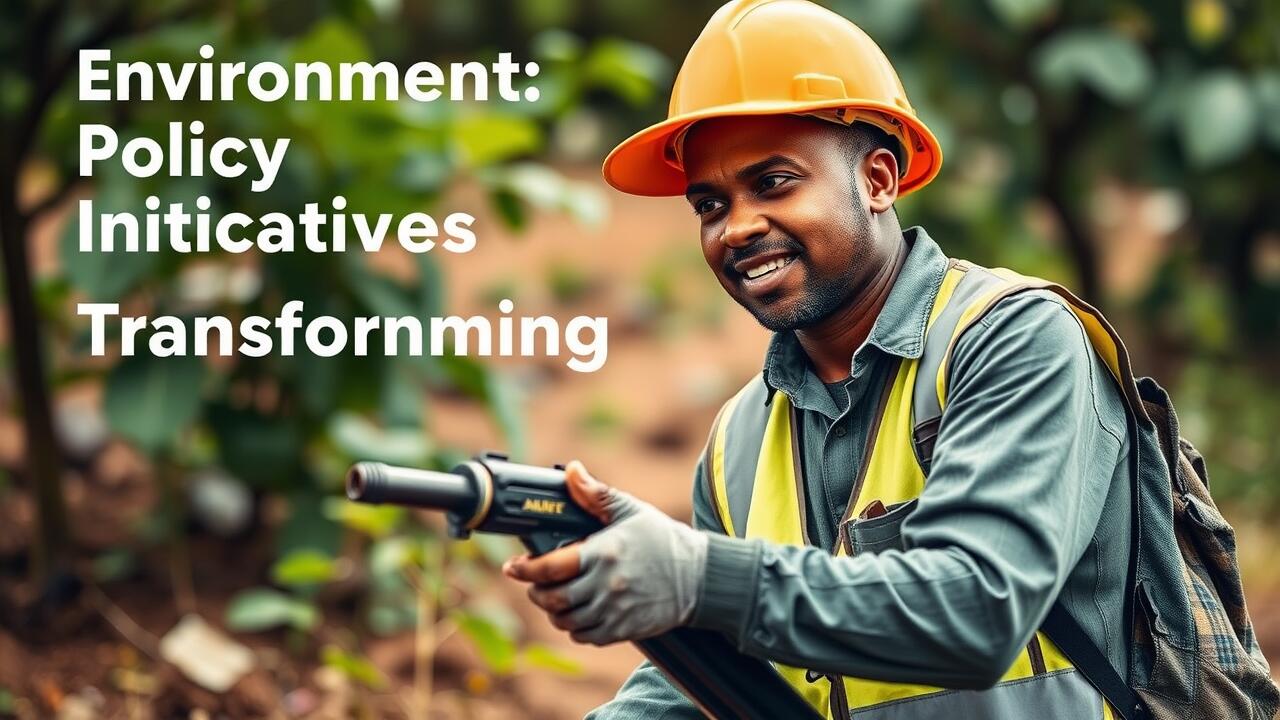Environmental Policy Initiatives Transforming Africa’s Landscape
Across the vast expanse of Africa, cities are in the throes of remarkable metamorphosis, fervently embracing sustainability’s guiding principles in urban design. The narrative has shifted dramatically—now spotlighting vibrant green spaces sprouting amidst concrete jungles, a renewed emphasis on public transportation that weaves through bustling streets, and the seamless integration of renewable energy sources powering infrastructures with an eco-friendly pulse.
These bold initiatives aren’t merely about slashing carbon footprints; they’re also about elevating urban life itself! Imagine a world where access to nature flourishes hand-in-hand with cleaner air—a sanctuary for community engagement blossoms right at your doorstep.
But wait—there’s more! Efforts underscore smart growth strategies that champion mixed-use developments and neighborhoods designed for walking rather than driving. Picture cities sculpted not just for efficiency but tailored to meet the rich tapestry of human needs while simultaneously nurturing our planet. Urban planners are crafting foundations for communities pulsing with resilience; it’s an exhilarating dance between local economies thriving and urban expansion that is sustainable yet equitable—mirroring the dreams and aspirations swirling within Africa’s rapidly evolving societies.
Integrating Sustainability in Urban Development
In the bustling urban landscapes of Africa, there’s a palpable shift—an awakening to the profound need for sustainable development as a guiding compass for future expansion. This transformation emerges from an urgent response to a tapestry of challenges: the whirlwind of rapid urbanization, the relentless march of climate change, and the ominous specter of resource depletion. City planners and local governments are stepping into this intricate arena with strategies that pulse with sustainability at their core. Think mixed-use developments that buzz with life, public transportation systems that hum efficiency, and green public spaces where nature intermingles harmoniously with concrete.
But weaving sustainability into the fabric of urban growth isn’t merely about flashy designs or high-tech solutions; it demands a rich tapestry woven by diverse stakeholders—government bodies engaging alongside private enterprises and civil society groups in spirited collaboration. Here lies the crux: effective policies and regulations act as catalysts in nurturing an ecosystem where sustainable practices can thrive unabated. Community engagement becomes paramount; it’s not just about policy but ensuring local voices resonate through every planning decision, crafting solutions that mirror residents’ needs and dreams.
As these cities embark on this ambitious journey toward implementing sustainable practices within their urban framework, they’re not just building structures—they’re setting down roots for a more harmonious coexistence between burgeoning cityscapes and environmental guardianship. The future beckons—a complex dance between growth and preservation awaits!
Environmental Education and Awareness
Access to information is nothing short of a lifeline for cultivating environmental awareness in African communities. A tapestry of initiatives weaves through the continent, each one striving to enlighten the public on sustainability while unraveling the complex web connecting human actions and the natural world. These programs are not monolithic; they cater to an array of demographics—students yearning for knowledge, local leaders seeking guidance, and community organizations aiming to make a difference. This educational push sparks a flicker of responsibility, nudging individuals towards embracing eco-friendly habits in their everyday lives.
But that’s just scratching the surface! By weaving environmental education into school curricula, we’re witnessing a remarkable transformation—a generation of eco-conscious citizens blossoming before our eyes. Imagine students diving into hands-on projects and rolling up their sleeves in community efforts! They’re not just learning about waste management or conservation; they’re becoming champions for change right where they live. These dynamic strategies do more than impart facts; they empower youth with the tools they need to advocate fiercely for positive transformations within their neighborhoods. Through this cultivation of environmental stewardship, these initiatives aren’t merely planting seeds—they’re nurturing an entire ecosystem poised for sustainable development across Africa’s diverse landscape.
Empowering Communities Through Knowledge
The flow of knowledge is like a lifeblood for communities striving to dive headfirst into the realm of environmental stewardship. Picture this: local workshops buzzing with energy, training sessions that spark curiosity, and awareness campaigns igniting passion—all vital in arming residents with the essential tools they need to grapple with the ecological hurdles looming on their horizon. When individuals are equipped with insights into sustainable practices, they transform into fervent champions for their environment. This newfound empowerment doesn’t just sit idly; it cultivates an invigorating sense of responsibility and ownership that drives proactive actions throughout the community to tackle pressing environmental dilemmas.
But wait—there’s more! Teaming up with educational institutions and non-governmental organizations can supercharge these initiatives, infusing them with fresh teaching techniques that break through barriers of understanding. Imagine interactive programs bursting forth to bridge gaps while sharpening critical thinking skills around local ecological issues! These educational endeavors don’t merely inform—they breed a vibrant culture of sustainability where community members engage deeply not only in learning about environmental challenges but also in crafting impactful solutions together. By building this expansive knowledge base, communities bolster their resilience against shifting environmental tides while paving pathways toward long-term sustainability aspirations.
Policy Frameworks Supporting Environmental Change
In recent years, a notable shift has unfolded across numerous African nations as they grapple with the pressing need for formidable policy frameworks to navigate the turbulent waters of environmental change. It’s a landscape where governments are increasingly harmonizing their national strategies with international accords, such as the Paris Climate Agreement—an intricate tapestry woven from ambitious aspirations and urgent realities. These frameworks act like navigational charts for sustainable development, meticulously delineating clear targets aimed at slashing carbon emissions while championing renewable energy sources.
But wait! There’s more beneath this surface: policies sprout like green shoots in springtime, designed not only to attract investment in cutting-edge green technologies but also to ignite sparks of innovation and job creation that ripple throughout the continent.
Ah, but it doesn’t stop there! The dance of collaboration is essential—a complex interplay between governments, NGOs, and private sectors takes center stage in effectively rolling out these initiatives. National environmental policies morph into tailored solutions suited to local contexts; think bespoke suits fitting snugly on unique bodies rather than one-size-fits-all drapery! This localized approach does wonders—it enhances community engagement by ensuring that diverse voices resonate within decision-making circles.
By cultivating a sense of ownership among local populations—a dynamic exchange where every stakeholder plays an integral role—these frameworks not only uplift sustainable practices but also kindle a spirit of environmental stewardship that resonates through all layers of society. Who knew that amidst the chaos and challenges lay such promise?
International Agreements and Local Implementation
International agreements wield immense influence over the environmental policies of African nations. They serve as a vital framework for collaboration, championing sustainable development while safeguarding natural resources. By pledging allegiance to global standards, countries can harmonize their national laws with international norms. This synchronization paves the way for a more cohesive strategy in managing environmental concerns across borders, empowering nations to jointly confront transboundary challenges like deforestation, biodiversity decline, and climate change.
Yet, the local execution of these agreements often grapples with substantial obstacles. Disparities in governance frameworks, resource accessibility, and levels of public awareness can stymie effective action. Although many nations embrace international commitments enthusiastically, translating those commitments into tangible actions at the grassroots level necessitates customized strategies that reflect unique regional circumstances. Involving local communities and stakeholders in this implementation journey is essential—not just for bolstering accountability but also for ensuring that policies genuinely resonate with the populace’s needs.
| International Agreement | Key Focus Areas | Signatory Countries | Implementation Challenges |
|---|---|---|---|
| Paris Agreement | Climate change mitigation | All African countries | Limited resources and capacity |
| Convention on Biological Diversity | Biodiversity conservation | 48 African nations | Lack of public awareness and engagement |
| United Nations Framework Convention on Climate Change | Climate action and support | 54 African countries | Governance and policy integration issues |
| Ramsar Convention on Wetlands | Wetland protection | 25 African nations | Overexploitation of resources |
Waste Management Solutions
Navigating the intricate maze of waste management in Africa is no small feat, especially as urbanization and population growth surge like a tide. Cities are now weaving advanced technologies into their fabric, aiming to fine-tune the often chaotic processes of waste collection and disposal. Picture this: waste-to-energy plants emerging on the scene, transforming organic refuse into energy gold while simultaneously alleviating the pressures mounting on our landfills. But that’s not all; local governments are shaking hands with private enterprises, forging alliances designed to boost recycling rates and birth innovative facilities for processing waste. This dynamic collaboration holds promise—ushering urban landscapes towards greener pastures.
Yet, at the heart of these initiatives lies community engagement—a vital pulse that can make or break success stories in waste management. Enter environmental education programs! They’re not just about facts and figures; they spark awareness among residents regarding proper disposal methods and recycling practices. Local campaigns? Think vibrant calls to action encouraging participation in clean-up drives and recycling efforts—the kind that instills a sense of ownership over one’s surroundings. When municipalities arm citizens with knowledge and resources, they ignite a cultural shift toward sustainability—a ripple effect leading to remarkable enhancements in both waste management systems and urban wellness overall.
Innovations in Recycling and Waste Reduction
Africa is witnessing a whirlwind of transformation in the realm of recycling technologies and methodologies, all sparked by the urgent need to tackle an escalating waste crisis. Picture this: mobile recycling units roving through urban landscapes alongside community-driven collection systems—these innovative approaches are not just gaining traction; they’re thriving! Local labor takes center stage, infusing communities with energy and engagement while opening doors to economic opportunities that were previously locked tight.
And then there’s technology, weaving its magic into the fabric of waste management. Imagine software applications designed for sorting and tracking recyclables—tools that elevate efficiency and ensure we snag higher recovery rates than ever before. It’s like watching a well-orchestrated dance between man and machine!
But wait—there’s more! Educational campaigns are popping up everywhere, igniting awareness about the critical importance of reducing waste. Schools partner with local organizations to craft programs that enlighten both children and adults on the myriad benefits of sustainability. These efforts don’t merely advocate for recycling; they spotlight waste reduction right at its source, nudging individuals toward more mindful consumption practices.
As these vibrant initiatives flourish within communities, envisioning a circular economy transforms from mere aspiration into palpable reality—a world where innovation meets responsibility in an exhilarating embrace!
- Enhanced community engagement through local recycling initiatives fosters a sense of ownership.
- Implementation of mobile recycling units increases accessibility and convenience for waste collection.
- Advanced technologies streamline the sorting process, improving operational efficiency for recycling facilities.
- Educational programs in schools build a foundation of sustainability awareness among future generations.
- Collaboration between local governments and organizations enhances resource sharing and support for recycling efforts.
- Incentives for community involvement encourage participation in waste reduction activities.
- Continuous innovation in materials science leads to the development of more recyclable and sustainable products.
The Impact of International Aid on Environmental Policies
International aid weaves a complex tapestry in the realm of environmental policies across Africa, its threads rich with impact and nuance. With funding and technical support pouring in from donor nations and global organizations, countries find themselves empowered to forge paths toward sustainable practices while fortifying their regulatory frameworks. These resources aren’t just numbers on a balance sheet; they spark initiatives tackling urgent environmental dilemmas—from grappling with the multifaceted beast of climate change adaptation to safeguarding precious biodiversity.
Yet, here’s where it gets intriguing: aid often comes laced with specific expectations that demand accountability and transparency within the intricate dance of environmental governance. The efficacy of these programs hangs delicately in the balance, heavily relying on local engagement and how adeptly governments weave this external assistance into their pre-existing policy landscapes.
Imagine this: when international priorities sync harmoniously with local needs, foreign assistance can morph into a powerful catalyst for transformative change—ushering in successful environmental initiatives that resonate deeply within communities. Moreover, donor involvement doesn’t merely drop funds from above; it encourages an exchange of knowledge and capacity building—a veritable fountain of resilience and innovation bubbling up through diverse environmental management practices across this vibrant continent.
Evaluating Effectiveness and Outcomes
The landscape of environmental policies in Africa is a tapestry woven with complexity, where the effectiveness is scrutinized through an array of metrics—think emissions reductions dancing alongside biodiversity boosts and community engagement rates. To truly grasp these outcomes, one must embrace a multifaceted lens, harmonizing both qualitative richness and quantitative precision. A growing number of nations are now weaving in monitoring frameworks that delve into the tangible impacts of their strategies on the ground. This systematic evaluation not only illuminates successful initiatives but also casts light on those shadowy corners that cry out for improvement.
International aid emerges as a pivotal player, sculpting the contours of environmental policy by injecting vital resources and expertise into the mix. But to gauge the true efficacy of this assistance, we must look beyond mere funding; we need to assess how sustainable and long-lasting these projects really are when buoyed by foreign support. Sure, some initiatives shine brightly with commendable results—but lurking beneath are challenges like dependency on aid and potential mismatches between donor intentions and local aspirations. It’s through rigorous evaluation that more fruitful collaborations can blossom, ensuring that environmental policies resonate deeply with the distinct needs pulsating within African nations.
Conclusion
Africa is currently navigating a remarkable shift in the realm of environmental policy initiatives, a vibrant tapestry woven with threads of innovation. Picture this: sustainable practices are not merely stitched into urban planning but boldly redefine the landscapes of both bustling cities and tranquil rural areas. A surge of community awareness and education fuels these changes—grassroots movements, ignited by local wisdom, act as dynamic catalysts for transformation that sync seamlessly with broader policy frameworks mandated by international agreements.
Consider the strides being made in waste management and inventive recycling techniques; they showcase an unwavering commitment to tackling pressing environmental challenges head-on. The involvement of international aid underscores a united front aimed at ensuring effective execution and ongoing assessment of these vital policies. As collaboration deepens and dedication remains steadfast, Africa finds itself at a crossroads—a moment where sustainable development holds the promise to carve out pathways for not just a greener world but one imbued with resilience for generations to come.







